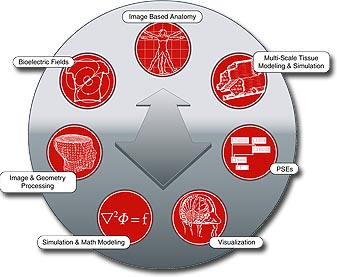 SCI is pleased to announce the launch of our new NCRR Center for Integrative Biomedical Computing (CIBC), a five year extension of our previous NCRR center but with a new broader scope. With the new center, we will be conducting exciting research and development that builds upon the successes of previous investments, enhancing our existing strengths, and responding to a set of compelling new biomedical problems. We will continue to develop integrated problem solving environments that make advanced computational tools available to biomedical scientists. We will also continue to pursue advanced research in technical and biophysical approaches to bioelectric field problems in cardiology and neurology. Since the founding of our original NCRR Center, software research has evolved, and so too has our vision of how we can best design software to have the most impact on biomedical research. Integration is still at the core of this vision, though in order to more effectively serve researchers using other systems, we are moving away from our previous strategy of absorbing and incorporating other software into our system to what we call "bridging", in which we provide researchers with the flexibility to link to whatever software systems will meet their needs.
SCI is pleased to announce the launch of our new NCRR Center for Integrative Biomedical Computing (CIBC), a five year extension of our previous NCRR center but with a new broader scope. With the new center, we will be conducting exciting research and development that builds upon the successes of previous investments, enhancing our existing strengths, and responding to a set of compelling new biomedical problems. We will continue to develop integrated problem solving environments that make advanced computational tools available to biomedical scientists. We will also continue to pursue advanced research in technical and biophysical approaches to bioelectric field problems in cardiology and neurology. Since the founding of our original NCRR Center, software research has evolved, and so too has our vision of how we can best design software to have the most impact on biomedical research. Integration is still at the core of this vision, though in order to more effectively serve researchers using other systems, we are moving away from our previous strategy of absorbing and incorporating other software into our system to what we call "bridging", in which we provide researchers with the flexibility to link to whatever software systems will meet their needs. In order to build on our strengths and expand our technical and scientific mission, we have added an entirely new technical core - Biomedical Image and Geometry Processing. The new Center has also implemented a broader vision of mathematical modeling and simulation that goes well beyond its current concentration on modeling bioelectric fields of particular organs to encompass other anatomies and physics. Modern biomedical research is driven by discoveries at the molecular and cellular level, and by addressing these problems we will address the gap between many existing and emerging systems for cellular simulation and their manifestation at the level of the whole organ. Furthermore, from the study of electrical volume conductor problems, we will expand the biophysical scope of our systems to include dynamic cellular behavior, communication among cells in a syncytium, and tissue response to external influences such as electric current, MRI, and mechanical strain.
We are also working to increase the technologies available to biomedical researchers, both by leveraging our visualization expertise within the SCI Institute and carrying out new research in visualization directed at biomedically important areas such as time-dependent image data, bioelectric vector fields and other ion-transport behaviors, diffusion weighted MRI imaging, and data error/uncertainty. The Center will explore and evaluate these and other visualization techniques and combine these capabilities into customized and effective visualization tools and easy-to-use applications to be made available to the biomedical community.
 This center continues the partnership of the SCI Institute with Cardiovascular Research and Training Institute (CVRTI) and the Department of Electrical and Computer Engineering at Northeastern University. In addition, we have begun a novel, comprehensive approach to supporting collaborations which we call the "collaboration life cycle." The collaborations initiated within this new scheme will drive the technology of the Center through a set of clearly focused goals, regular review, and regular communication. An important target for each collaboration will be independent funding; in this way we hope to better help researchers meet their goals and also greatly expand the leverage and impact of the Center and its resources.
This center continues the partnership of the SCI Institute with Cardiovascular Research and Training Institute (CVRTI) and the Department of Electrical and Computer Engineering at Northeastern University. In addition, we have begun a novel, comprehensive approach to supporting collaborations which we call the "collaboration life cycle." The collaborations initiated within this new scheme will drive the technology of the Center through a set of clearly focused goals, regular review, and regular communication. An important target for each collaboration will be independent funding; in this way we hope to better help researchers meet their goals and also greatly expand the leverage and impact of the Center and its resources.To compliment the center, we have launched a dedicated web site where you can learn more about our research, download software and datasets, and access all kinds of other related material. We have also included a CIBC Wiki to facilitate collaboration and serve as a knowledgebase. Please check out the CIBC website to learn more about the groundbreaking research and development at our new NCRR/CIBC Center.
